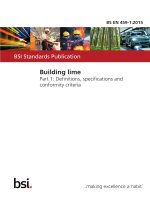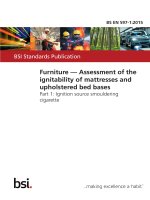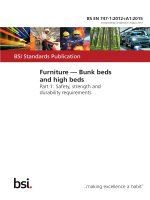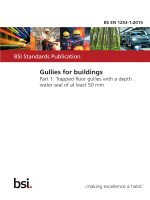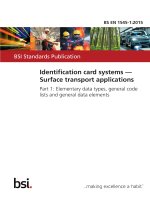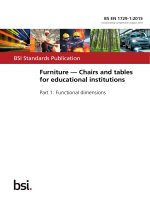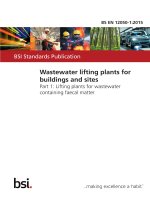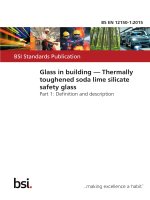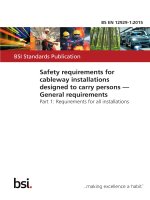Bsi bs en 62467 1 2015
Bạn đang xem bản rút gọn của tài liệu. Xem và tải ngay bản đầy đủ của tài liệu tại đây (1.32 MB, 32 trang )
BS EN 62467-1:2015
BSI Standards Publication
Medical electrical equipment —
Dosimetric instruments as used
in brachytherapy
Part 1: Instruments based on well-type
ionization chambers
BRITISH STANDARD
BS EN 62467-1:2015
National foreword
This British Standard is the UK implementation of EN 62467-1:2015. It is
identical to IEC 62467-1:2009.
The UK participation in its preparation was entrusted by Technical
Committee CH/62, Electrical Equipment in Medical Practice, to
Subcommittee CH/62/3, Equipment for radiotherapy, nuclear medicine and
radiation dosimetry.
A list of organizations represented on this committee can be obtained on
request to its secretary.
This publication does not purport to include all the necessary provisions of
a contract. Users are responsible for its correct application.
© The British Standards Institution 2015.
Published by BSI Standards Limited 2015
ISBN 978 0 580 57216 6
ICS 11.040.50; 11.040.60
Compliance with a British Standard cannot confer immunity from
legal obligations.
This British Standard was published under the authority of the
Standards Policy and Strategy Committee on 30 November 2015.
Amendments/corrigenda issued since publication
Date
Text affected
BS EN 62467-1:2015
EUROPEAN STANDARD
EN 62467-1
NORME EUROPÉENNE
EUROPÄISCHE NORM
October 2015
ICS 11.040.50; 11.040.60
English Version
Medical electrical equipment - Dosimetric instruments as used in
brachytherapy - Part 1: Instruments based on well-type
ionization chambers
(IEC 62467-1:2009)
Appareils électromédicaux - Instruments de dosimộtrie
utilisộs en curiethộrapie - Partie 1: Instruments conỗus pour
les chambres d'ionisation à puits
(IEC 62467-1:2009)
Medizinische elektrische Geräte - Dosimetriegeräte zur
Anwendung in der Brachytherapie - Teil 1: Messgeräte mit
Schachtionisationskammern
(IEC 62467-1:2009)
This European Standard was approved by CENELEC on 2015-09-15. CENELEC members are bound to comply with the CEN/CENELEC
Internal Regulations which stipulate the conditions for giving this European Standard the status of a national standard without any alteration.
Up-to-date lists and bibliographical references concerning such national standards may be obtained on application to the CEN-CENELEC
Management Centre or to any CENELEC member.
This European Standard exists in three official versions (English, French, German). A version in any other language made by translation
under the responsibility of a CENELEC member into its own language and notified to the CEN-CENELEC Management Centre has the
same status as the official versions.
CENELEC members are the national electrotechnical committees of Austria, Belgium, Bulgaria, Croatia, Cyprus, the Czech Republic,
Denmark, Estonia, Finland, Former Yugoslav Republic of Macedonia, France, Germany, Greece, Hungary, Iceland, Ireland, Italy, Latvia,
Lithuania, Luxembourg, Malta, the Netherlands, Norway, Poland, Portugal, Romania, Slovakia, Slovenia, Spain, Sweden, Switzerland,
Turkey and the United Kingdom.
European Committee for Electrotechnical Standardization
Comité Européen de Normalisation Electrotechnique
Europäisches Komitee für Elektrotechnische Normung
CEN-CENELEC Management Centre: Avenue Marnix 17, B-1000 Brussels
© 2015 CENELEC All rights of exploitation in any form and by any means reserved worldwide for CENELEC Members.
Ref. No. EN 62467-1:2015 E
BS EN 62467-1:2015
EN 62467-1:2015
European foreword
The text of document 62C/460/FDIS, future edition 1 of IEC 62467-1, prepared by SC 62C "Equipment
for radiotherapy, nuclear medicine and radiation dosimetry", of IEC/TC 62 "Electrical equipment in
medical practice" was submitted to the IEC-CENELEC parallel vote and approved by CENELEC as
EN 62467-1:2015.
The following dates are fixed:
•
latest date by which the document has to be implemented at
national level by publication of an identical national
standard or by endorsement
(dop)
2016-06-15
•
latest date by which the national standards conflicting with
the document have to be withdrawn
(dow)
2018-09-15
Attention is drawn to the possibility that some of the elements of this document may be the subject of
patent rights. CENELEC [and/or CEN] shall not be held responsible for identifying any or all such
patent rights.
This document has been prepared under a mandate given to CENELEC by the European Commission
and the European Free Trade Association, and supports essential requirements of EU Directive(s).
For the relationship with EU Directive 93/42/EEC, see informative Annex ZZ, which is an integral part
of this document.
Endorsement notice
The text of the International Standard IEC 62467-1:2009 was approved by CENELEC as a European
Standard without any modification.
In the official version, for Bibliography, the following notes have to be added for the standards indicated:
2
IEC 60601-1-3:2008
NOTE
Harmonized as EN 60601-1-3:2008 (not modified).
IEC 61010-1
NOTE
Harmonized as EN 61010-1.
IEC 61676:2002
NOTE
Harmonized as EN 61676:2002 (not modified).
BS EN 62467-1:2015
EN 62467-1:2015
Annex ZA
(normative)
Normative references to international publications
with their corresponding European publications
The following documents, in whole or in part, are normatively referenced in this document and are
indispensable for its application. For dated references, only the edition cited applies. For undated
references, the latest edition of the referenced document (including any amendments) applies.
NOTE 1
When an International Publication has been modified by common modifications, indicated by (mod),
the relevant EN/HD applies.
NOTE 2
Up-to-date information on the latest versions of the European Standards listed in this annex is
available here: www.cenelec.eu.
Publication
Year
Title
EN/HD
Year
IEC 60050-393
2003
International Electrotechnical Vocabulary Part 393: Nuclear instrumentation Physical phenomena and basic concepts
-
-
IEC 60417
-
Graphical symbols for use on equipment
-
-
IEC 60580
2000
Medical electrical equipment - Dose area
product meters
EN 60580
2000
IEC 60601-1
2005
EN 60601-1
2006
-
-
+ corrigendum Mar.
2010
-
-
Medical electrical equipment Part 1: General requirements for basic
safety and essential performance
+ A12
2014
IEC 60731
1997
Medical electrical equipment - Dosimeters
with ionization chambers as used in
radiotherapy
-
-
IEC/TR 60788
2004
Medical electrical equipment - Glossary of
defined terms
-
-
IEC 61187
-
Electrical and electronic measuring
equipment - Documentation
EN 61187
-
IEC 61674
1997
Medical electrical equipment - Dosimeters
with ionization chambers and/or semiconductor detectors as used in X-ray
diagnostic imaging
EN 61674
1997
ISO/IEC Guide 99
2007
International vocabulary of metrology Basic and general concepts and
associated terms (VIM)
-
-
3
BS EN 62467-1:2015
EN 62467-1:2015
Annex ZZ
(informative)
Coverage of Essential Requirements of EU Directives
This European Standard has been prepared under a mandate given to CENELEC by the European
Commission and the European Free Trade Association, and within its scope the Standard covers all
relevant essential requirements given in Annex I of EU Directive 93/42/EEC of 14 June 1993
concerning medical devices.
Compliance with this standard provides one means of conformity with the specified essential
requirements of the Directive concerned.
WARNING: Other requirements and other EU Directives can be applied to the products falling within
the scope of this standard.
4
BS EN 62467-1:2015
–2–
62467-1 IEC:2009
CONTENTS
FOREWORD...........................................................................................................................4
INTRODUCTION.....................................................................................................................6
1
Scope and object..............................................................................................................7
2
Normative references .......................................................................................................7
3
Terms and definitions .......................................................................................................8
4
General requirements ..................................................................................................... 12
4.1
4.2
4.3
5
P ERFORMANCE REQUIREMENTS ................................................................................. 12
M EASURING ASSEMBLY ............................................................................................ 12
Source types ......................................................................................................... 12
4.3.1 General ..................................................................................................... 12
4.3.2 Beta particle-emitting sources ................................................................... 13
4.3.3 Low-energy-photon-emitting sources ......................................................... 13
4.4 Quantity to be measured ....................................................................................... 13
4.5 Reference and STANDARD TEST CONDITIONS ............................................................ 13
4.6 General test conditions.......................................................................................... 13
4.6.1 S TANDARD TEST CONDITIONS ........................................................................ 13
4.6.2 S TABILIZATION TIME ..................................................................................... 13
4.6.3 Adjustments during test ............................................................................. 14
4.6.4 Batteries .................................................................................................... 14
4.7 Constructional requirements as related to performance ......................................... 14
4.7.1 General ..................................................................................................... 14
4.7.2 Components .............................................................................................. 14
4.7.3 Display ...................................................................................................... 14
4.7.4 Inserts ....................................................................................................... 14
4.7.5 S TABILIZATION TIME ..................................................................................... 14
4.8 Test of components ............................................................................................... 15
Limits of performance characteristics.............................................................................. 15
5.1
5.2
5.3
5.4
5.5
6
Position of source in insert and repeatability ......................................................... 15
U SABLE LENGTH ...................................................................................................... 15
R ESOLUTION OF THE DISPLAY ................................................................................... 15
S TABILIZATION TIME ................................................................................................. 15
L EAKAGE CURRENT .................................................................................................. 16
5.5.1 In AIR KERMA STRENGTH measuring mode.................................................... 16
5.5.2 In charge measuring mode ........................................................................ 16
5.6 Stability ................................................................................................................. 16
5.6.1 Long term stability ..................................................................................... 16
5.6.2 M ANUFACTURER method to check long term stability ................................... 16
L IMITS OF VARIATION for effects of influence quantities ..................................................... 16
6.1
6.2
6.3
6.4
6.5
General ................................................................................................................. 16
I ONIZATION CHAMBER – recombination losses .......................................................... 17
Operating voltage .................................................................................................. 17
6.3.1 Mains operated MEASURING ASSEMBLY ........................................................ 17
6.3.2 Battery operated MEASURING ASSEMBLY ...................................................... 17
6.3.3 Rechargeable MEASURING ASSEMBLY ........................................................... 18
Air pressure........................................................................................................... 18
Change of air pressure and EQUILIBRATION TIME of the radiation detector ............... 18
BS EN 62467-1:2015
62467-1 IEC:2009
–3–
7
6.5.1 V ENTED WELL TYPE IONIZATION CHAMBERS .................................................... 18
6.5.2 S EALED WELL TYPE IONIZATION CHAMBERS ..................................................... 19
6.6 Temperature and humidity ..................................................................................... 19
6.7 Length RESPONSE .................................................................................................. 19
6.8 Electromagnetic immunity...................................................................................... 20
Marking .......................................................................................................................... 20
8
7.1 W ELL - TYPE IONIZATION CHAMBER ASSEMBLY .............................................................. 20
7.2 M EASURING ASSEMBLY ............................................................................................ 20
A CCOMPANYING DOCUMENTS ............................................................................................. 20
8.1 General ................................................................................................................. 20
8.2 Use of the instrument ............................................................................................ 20
8.3 Documentation ...................................................................................................... 21
Bibliography.......................................................................................................................... 22
Index of defined terms .......................................................................................................... 23
Table 1 – R EFERENCE and STANDARD TEST CONDITIONS ........................................................... 13
Table 2 – L IMITS OF VARIATION for the effects of INFLUENCE QUANTITIES ................................... 17
BS EN 62467-1:2015
–4–
62467-1 IEC:2009
INTERNATIONAL ELECTROTECHNICAL COMMISSION
____________
MEDICAL ELECTRICAL EQUIPMENT –
DOSIMETRIC INSTRUMENTS AS USED IN BRACHYTHERAPY –
Part 1: Instruments based on well-type ionization chambers
FOREWORD
1) The International Electrotechnical Commission (IEC) is a worldwide organization for standardization comprising
all national electrotechnical committees (IEC National Committees). The object of IEC is to promote
international co-operation on all questions concerning standardization in the electrical and electronic fields. To
this end and in addition to other activities, IEC publishes International Standards, Technical Specifications,
Technical Reports, Publicly Available Specifications (PAS) and Guides (hereafter referred to as “IEC
Publication(s)”). Their preparation is entrusted to technical committees; any IEC National Committee interested
in the subject dealt with may participate in this preparatory work. International, governmental and nongovernmental organizations liaising with the IEC also participate in this preparation. IEC collaborates closely
with the International Organization for Standardization (ISO) in accordance with conditions determined by
agreement between the two organizations.
2) The formal decisions or agreements of IEC on technical matters express, as nearly as possible, an international
consensus of opinion on the relevant subjects since each technical committee has representation from all
interested IEC National Committees.
3) IEC Publications have the form of recommendations for international use and are accepted by IEC National
Committees in that sense. While all reasonable efforts are made to ensure that the technical content of IEC
Publications is accurate, IEC cannot be held responsible for the way in which they are used or for any
misinterpretation by any end user.
4) In order to promote international uniformity, IEC National Committees undertake to apply IEC Publications
transparently to the maximum extent possible in their national and regional publications. Any divergence
between any IEC Publication and the corresponding national or regional publication shall be clearly indicated in
the latter.
5) IEC provides no marking procedure to indicate its approval and cannot be rendered responsible for any
equipment declared to be in conformity with an IEC Publication.
6) All users should ensure that they have the latest edition of this publication.
7) No liability shall attach to IEC or its directors, employees, servants or agents including individual experts and
members of its technical committees and IEC National Committees for any personal injury, property damage or
other damage of any nature whatsoever, whether direct or indirect, or for costs (including legal fees) and
expenses arising out of the publication, use of, or reliance upon, this IEC Publication or any other IEC
Publications.
8) Attention is drawn to the Normative references cited in this publication. Use of the referenced publications is
indispensable for the correct application of this publication.
9) Attention is drawn to the possibility that some of the elements of this IEC Publication may be the subject of
patent rights. IEC shall not be held responsible for identifying any or all such patent rights.
International Standard IEC 62467-1 has been prepared by subcommittee 62C, Equipment for
radiotherapy, nuclear medicine and radiation dosimetry, of IEC technical committee 62,
Electrical equipment in medical practice.
The text of this standard is based on the following documents:
FDIS
Report on voting
62C/460/FDIS
62C/468/RVD
Full information on the voting for the approval of this standard can be found in the report on
voting indicated in the above table.
This publication has been drafted in accordance with the ISO/IEC Directives, Part 2.
BS EN 62467-1:2015
62467-1 IEC:2009
–5–
A list of all parts of the IEC 62467 series, published under the general title Medical electrical
equipment – Dosimetric instruments as used in brachytherapy, can be found on the IEC
website.
In this standard the following print types are used: Requirements, compliance with which can
be tested, and definitions: in roman type;
–
notes, explanations, advice, general statements and exceptions: in small roman type;
–
test specifications: in italic type;
−
TERMS USED THROUGHOUT THIS STANDARD THAT HAVE BEEN DEFINED IN C LAUSE
PUBLICATIONS INDICATED IN THE INDEX OF DEFINED TERMS : IN SMALL CAPITALS .
3 OR IN THE
The committee has decided that the contents of this publication will remain unchanged until
the maintenance result date indicated on the IEC web site under "" in
the data related to the specific publication. At this date, the publication will be
•
•
•
•
reconfirmed,
withdrawn,
replaced by a revised edition, or
amended.
BS EN 62467-1:2015
–6–
62467-1 IEC:2009
INTRODUCTION
The wide range of WELL - TYPE IONIZATION CHAMBER instruments currently being used for
sources indicates the need for a standard for uniformity in measurement and
test techniques for WELL -TYPE IONIZATION CHAMBER instruments. Measurements of the output of
BRACHYTHERAPY sources have distinct requirements that differ from the assay of sources used
in diagnostic nuclear medicine. This translates into the requirements for the measurement
devices. Many times similar instrumentation is used for both applications; however, there are
tighter requirements for those instruments used for BRACHYTHERAPY sources. Such devices
are composite systems consisting of an IONIZATION CHAMBER , either integrally coupled or
connected to appropriate electronic circuitry that converts the ionization current to a readout,
which can be converted to a quantity appropriate to the source being measured. The
ionization current produced can be either read directly or as accumulated charge (current
integrated over time) and then converted manually to the appropriate quantity, AIR KERMA
STRENGTH ( REFERENCE AIR KERMA RATE ) or ABSORBED DOSE TO WATER . The principles of
operation of the IONIZATION CHAMBER are well known and are not repeated here. In addition,
the readout device many times also has application to therapy uses and is well known.
Although this standard is written using the quantity AIR KERMA STRENGTH , the principles are the
same for other quantities such as REFERENCE AIR KERMA RATE .
BRACHYTHERAPY
In principle the quantity measured is the dose volume integral from which under specified
conditions the dose quantities AIR KERMA STRENGTH , REFERENCE AIR KERMA RATE , or ABSORBED
DOSE TO WATER at a depth can be deduced. The signal produced by the chamber is the
electrical current or charge, which is to be measured with an electrometer meeting criteria
according to IEC 60731. The current or charge is converted to the dosimetric quantity of
interest by means of a source type specific CALIBRATION FACTOR .
BS EN 62467-1:2015
62467-1 IEC:2009
–7–
MEDICAL ELECTRICAL EQUIPMENT –
DOSIMETRIC INSTRUMENTS AS USED IN BRACHYTHERAPY –
Part 1: Instruments based on well-type ionization chambers
1
Scope and object
This part of IEC 62467 specifies the performance and some related constructional
requirements of WELL - TYPE IONIZATION CHAMBERS and associated measurement apparatus, as
defined in Clause 3, intended for the determination of a quantity, such as AIR KERMA STRENGTH
or REFERENCE AIR KERMA RATE in photon radiation fields or ABSORBED DOSE TO WATER at a
depth, in photon and beta radiation fields used in BRACHYTHERAPY , after appropriate
calibration for a given type of source.
This International Standard covers the techniques for the quantification of the quantity
appropriate for the BRACHYTHERAPY source under consideration. This quantity may be AIR
KERMA STRENGTH or REFERENCE AIR KERMA RATE at 1 m, or ABSORBED DOSE TO WATER at a depth
(e.g. 2 mm or 5 mm). Measurement of these quantities may be accomplished by a variety of
WELL - TYPE IONIZATION CHAMBERS or systems currently available for this purpose. This standard
applies to products intended for low dose rate, high dose rate, intravascular, both photon and
beta, BRACHYTHERAPY measurements. It does not apply to instruments for nuclear medicine
applications. The application of the standard is limited to instruments that incorporate WELL TYPE IONIZATION CHAMBERS as detectors.
The intended use is the measurement of the output of radioactive, encapsulated sources for
intracavitary (insertion into body cavities) or interstitial (insertion into body tissue)
applications.
The object of this standard is
a) to establish requirements for a satisfactory level of performance for WELL - TYPE CHAMBER
SYSTEMS , and
b) to standardize the methods for the determination of compliance with this level of
performance.
This standard is not concerned with the safety aspects of WELL - TYPE CHAMBER SYSTEMS . The
covered by this standard are not intended for use in patient
environment. The electrical safety of WELL - TYPE CHAMBER SYSTEMS is covered in IEC 61010-1.
The operation of the electrometer measuring system is covered in IEC 60731.
WELL - TYPE CHAMBER SYSTEMS
2
Normative references
The following referenced documents are indispensable for the application of this document.
For dated references, only the edition cited applies. For undated references, the latest edition
of the referenced document (including any amendments) applies.
IEC 60050-393:2003, International Electrotechnical Vocabulary
instrumentation – Physical phenomena and basic concepts
–
Part
IEC 60417, Graphical symbols for use on equipment
IEC 60580:2003, Medical electrical equipment – Dose area product meters
393:
Nuclear
BS EN 62467-1:2015
–8–
62467-1 IEC:2009
IEC 60601-1:2005, Medical electrical equipment – Part 1: General requirements for basic
safety and essential performance
IEC 60731:1997, Medical electrical equipment – Dosimeters with ionization chambers as used
in radiotherapy
IEC/TR 60788:2004, Medical electrical equipment – Glossary of defined terms
IEC 61187, Electrical and electronic measuring equipment – Documentation
IEC 61674:1997, Medical electrical equipment – Dosimeters with ionization chambers and/or
semi-conductor detectors as used in X-ray diagnostic imaging
ISO/IEC Guide 99, International vocabulary of metrology – Basic and general concepts and
associated terms (VIM)
3
Terms and definitions
For the purposes of this document the following definitions apply.
The definitions given in this standard are generally in agreement with those in IEC/TR 60788
and ISO/IEC Guide 99 (IVM). Any term not defined in this clause or in the relevant
publications cited in the Index of defined terms has the meaning defined in IEC/TR 60788 and
ISO/IEC Guide 99 or is assumed to be in general scientific usage.
3.1
absorbed dose to water
D
quotient of d ε by dm where d ε is the mean energy imparted by IONIZING RADIATION to water of
mass dm
NOTE 1
The unit of ABSORBED DOSE TO W ATER is Gy (where 1 Gy = 1 J·kg –1 ).
NOTE 2
This definition is derived from the definition in C.4 of ICRU 33 (see Bibliography).
[IEC 60731:1997, definition 3.26]
3.2
air kerma strength
product of AIR KERMA RATE in free space (in vacuo) due to photons greater than a low energy
cut off and the square of the distance of the calibration point from the source centre along the
perpendicular bisector
NOTE 1
Energy cut-off is generally 5 keV.
NOTE 2
The unit is Gy m 2 /s.
NOTE 3
In practice the unit μGy m 2 /h is used frequently.
3.3
chamber assembly leakage current
leakage current
any current in the signal path arising in the CHAMBER ASSEMBLY which is not produced by
ionization in the measuring volume
NOTE
It is distinguished from ZERO DRIFT or ZERO SHIFT which arises in the MEASURING ASSEMBLY .
BS EN 62467-1:2015
62467-1 IEC:2009
–9–
3.4
correction factor
dimensionless multiplier which corrects the INDICATED VALUE of an instrument from its value
when operated under particular conditions to its value when operated under stated REFERENCE
CONDITIONS
[IEC 60731:1997, definition 3.6]
3.5
effective range
effective range of indicated values
range of INDICATED VALUES for which an instrument complies with a stated performance
NOTE 1
The maximum (minimum) EFFECTIVE INDICATED VALUE is the highest (lowest) in this range.
NOTE 2 The concept of EFFECTIVE RANGE may, for example, also be applied to scale readings and to related
quantities not directly indicated by the instrument e.g. input current.
[IEC 60731:1997, definition 3.15]
3.6
equilibration time
time taken for a scale reading to reach and remain within a specified deviation from its final
steady value after a sudden change in an INFLUENCE QUANTITY has been applied to the
instrument
[IEC 60731:1997, definition 3.12.3]
3.7
error of measurement
difference remaining between the MEASURED VALUE of a quantity and the TRUE VALUE of that
quantity
[IEC 60731:1997, definition 3.5.1]
3.8
indicated value
value of a quantity derived from the scale reading of an instrument together with any scale
factors indicated on the control panel of the instrument
[IEC 60731:1997, definition 3.2]
3.9
influence quantity
any external quantity that may affect the performance of an instrument
[IEC 60731:1997, definition 3.7]
NOTE
E.g. ambient temperature, radiation quality etc.
3.10
instrument parameter
any internal property of an instrument that may affect the performance of this instrument
[IEC 60731:1997, definition 3.8]
BS EN 62467-1:2015
– 10 –
62467-1 IEC:2009
3.11
measured value
best estimate of the TRUE VALUE of a quantity, being derived from the INDICATED VALUE of an
instrument together with the application of all relevant CORRECTION FACTORS and the
CALIBRATION FACTOR
[IEC 60731:1997, definition 3.5]
3.12
measuring assembly
<WELL - TYPE IONIZATION CHAMBERS > device to measure the charge (or current) from the WELL TYPE IONIZATION CHAMBER and possibly convert it into a form suitable for the quantity to be
measured
3.13
overall uncertainty
uncertainty associated with the MEASURED VALUE
NOTE 1
I.e. representing the bounds within which the ERROR OF MEASUREMENT is estimated to lie.
[IEC 60731:1997, definition 3.5.2, modified]
NOTE 2
See also Clause 5.
3.14
reference air kerma rate
AIR KERMA RATE in free space (in vacuo) due to photons greater than a low energy cut off at
the distance of 1 m
NOTE 1
Energy cut-off is generally 5 keV.
NOTE 2
The unit is Gy/s.
NOTE 3
In practice the unit μGy/h is used frequently.
NOTE 4
The AIR KERMA STRENGTH is numerically identical to the REFERENCE AIR KERMA RATE .
3.15
reference conditions
conditions under which all influence quantities and INSTRUMENT PARAMETERS have their
REFERENCE VALUES
[IEC 60731:1997, definition 3.9.1]
3.16
reference point of a well-type chamber
point of maximum signal for a specified point source along the measuring length of a WELL TYPE IONIZATION CHAMBER
NOTE
The term reference point is often referred to as "sweet spot".
3.17
reference value
particular value of an INFLUENCE QUANTITY or INSTRUMENT PARAMETER chosen for the purpose
of reference
[IEC 60731:1997, definition 3.9, modified]
NOTE I.e. the value of an INFLUENCE QUANTITY (or INSTRUMENT PARAMETER ) at which the CORRECTION FACTOR for
dependence on that INFLUENCE QUANTITY (or INSTRUMENT PARAMETER ) is unity.
BS EN 62467-1:2015
62467-1 IEC:2009
– 11 –
3.18
response
IONIZATION CHAMBER > quotient of the INDICATED
CONVENTIONAL TRUE VALUE of the REFERENCE AIR KERMA RATE (in 1 m
VALUE divided by the
distance from the source)
3.19
sealed well-type ionization chamber
a WELL - TYPE IONIZATION CHAMBER constructed in such a way as to restrict the pathway between
the air inside the measuring volume and the atmosphere to insure that the RESPONSE of the
chamber is independent of changes in ambient conditions over a period of time stated by the
MANUFACTURER
3.20
stabilization time
time taken for a stated PERFORMANCE CHARACTERISTIC to reach and remain within a specified
deviation from its final steady value after the MEASURING ASSEMBLY has been switched on and
the polarizing voltage has been applied to the IONIZATION CHAMBER
[IEC 60731:1997, definition 3.12.5]
3.21
standard test conditions
conditions under which all INFLUENCE QUANTITIES and INSTRUMENT PARAMETERS have their
STANDARD TEST VALUES
[IEC 60731:1997, definition 3.10.1]
3.22
standard test value
value, values, or range of values of an INFLUENCE QUANTITY or INSTRUMENT PARAMETER , which
are permitted when carrying out calibrations or tests on another INFLUENCE QUANTITY or
INSTRUMENT PARAMETER
[IEC 60731:1997, definition 3.10]
3.23
stray radiation
for IONIZING RADIATION , all radiation except that of the specified RADIATION BEAM under
consideration, but including its RESIDUAL RADIATION
[IEC 60601-1-3:2008, 3.75]
3.24
true value
value of the physical quantity to be measured by an instrument
[IEC 60731:1997, definition 3.3]
3.25
usable length
length along the axis of a WELL - TYPE IONIZATION CHAMBER between the two points at which the
signal for a specified point source has fallen to a specified portion of the signal at the
REFERENCE POINT OF A WELL - TYPE CHAMBER
NOTE
The term USABLE LENGTH is often referred to as "sweet length".
BS EN 62467-1:2015
– 12 –
62467-1 IEC:2009
3.26
vented well-type ionization chamber
a WELL - TYPE IONIZATION CHAMBER constructed in such a way as to allow the air inside the
measuring volume to communicate freely with the atmosphere such that corrections to the
RESPONSE for changes in air density need to be made
3.27
well-type chamber system
combined WELL - TYPE IONIZATION CHAMBER and MEASURING ASSEMBLY to obtain the reading
which can be converted to the quantity to be measured
3.28
well-type ionization chamber
detector in which the BRACHYTHERAPY source is inserted into the IONIZATION CHAMBER
NOTE The solid angle over which a W ELL - TYPE IONIZATION CHAMBER is sensitive to radiation should be of the order
of 4 π, where the exact value of the solid angle is not relevant.
4
General requirements
4.1
P ERFORMANCE REQUIREMENTS
Each of the components of a WELL - TYPE CHAMBER SYSTEM shall comply with the individual
requirements in the appropriate clauses or subclauses in addition to the general
requirements. The instruments shall be installed and operated in accordance with the
MANUFACTURER ’s instructions.
In Clauses 5 and 6, the performance requirements are stated for a complete WELL - TYPE
CHAMBER SYSTEM including both the WELL - TYPE IONIZATION CHAMBER and MEASURING ASSEMBLY .
For a MEASURING ASSEMBLY designed to operate with one or more WELL - TYPE IONIZATION
CHAMBERS , each combination of the WELL - TYPE CHAMBER SYSTEM shall comply with the
requirements in 4.4, and in Clauses 5 and 6 relevant to this combination.
During the immunity tests for electromagnetic compatibility (see IEC 60731) BASIC SAFETY and
shall be guaranteed.
ESSENTIAL PERFORMANCE
E SSENTIAL PERFORMANCE is guaranteed if the limits listed in Table 2 are not exceeded during
the immunity tests. E SSENTIAL PERFORMANCE is also ensured if during the immunity tests the
reading of the MEASURING ASSEMBLY , or the data output, are clearly characterized as invalid,
e.g. by means of a warning message or in case of a latch-up.
NOTE
Examples for warning messages for invalid readings are high voltage error or overload messages.
4.2
M EASURING ASSEMBLY
The MEASURING ASSEMBLY shall conform to field class instruments of IEC 60731, unless stated
otherwise.
4.3
4.3.1
Source types
General
The BRACHYTHERAPY source determines the insert used in the WELL - TYPE IONIZATION CHAMBER .
For each BRACHYTHERAPY source type, the MANUFACTURER of the WELL - TYPE IONIZATION
CHAMBER shall specify the insert type to be used. The tests below shall be made with the
insert type specified by the MANUFACTURER of the WELL - TYPE IONIZATION CHAMBER.
BS EN 62467-1:2015
62467-1 IEC:2009
4.3.2
– 13 –
Beta particle-emitting sources
Measurements on beta particle-emitting sources of the same radionuclide and activity will
vary greatly with insert composition (for example glass versus plastic) and wall thickness.
Some inserts depend on a measure of BREMSSTRAHLUNG produced by the deceleration of the
beta particles in the insert material; other inserts are designed to measure the betas directly.
Reproducible measurements depend upon consistent insert selection and consistency in the
manner in which the instrument is used.
4.3.3
Low-energy-photon-emitting sources
The wall thickness of the insert plus the thickness of the interior wall of the WELL - TYPE
may cause a significant attenuation for low-energy photons. Wide
variations in wall materials and source materials may result in variations in RESPONSE .
IONIZATION CHAMBER
4.4
Quantity to be measured
The following quantities are used: AIR KERMA STRENGTH in units of Gy m 2 /s, ABSORBED DOSE
RATE TO WATER at a specified distance from the source in units of Gy/s, REFERENCE AIR KERMA
RATE in units of Gy/s.
NOTE
In practice the units Gy m 2 /h and Gy/h are used frequently.
4.5
Reference and STANDARD TEST CONDITIONS
The values of the reference and STANDARD TEST CONDITIONS are given in Table 1.
Table 1 – R EFERENCE and STANDARD TEST CONDITIONS
4.6
4.6.1
I NFLUENCE QUANTITY
R EFERENCE VALUES
S TANDARD TEST VALUES
Temperature
+20 °C
+15 °C to +25 °C
Relative humidity
50 %
30 % to 75 %
Air pressure
101,3 kPa
Atmospheric pressure
S TABILIZATION TIME
15 min after switch-on
≥ 15 min after switch-on
Polarizing voltage
Stated by MANUFACTURER
R EFERENCE VALUE ±5 %
S TRAY RADIATION
Zero
As small as possible
Saturation losses
Full saturation
≤ 1 % saturation loss
Electromagnetic fields
Zero
Insignificant
General test conditions
S TANDARD TEST CONDITIONS
The STANDARD TEST CONDITIONS listed in Table 1 shall be met during the test procedure except
a) for the INFLUENCE QUANTITY under investigation;
b) where local conditions of temperature and relative humidity are outside the STANDARD TEST
CONDITIONS . In this case the tester shall demonstrate the validity of the test results.
4.6.2
S TABILIZATION TIME
Before the start of the compliance test, the instrument under test shall be switched on for at
least the STABILIZATION TIME .
BS EN 62467-1:2015
– 14 –
62467-1 IEC:2009
In addition, the WELL - TYPE IONIZATION CHAMBER should be allowed to attain thermal equilibrium
with the environment and should have the polarizing voltage applied for a period of time equal
to or greater than the specified STABILIZATION TIME .
4.6.3
Adjustments during test
Compliance tests shall be performed with the instrument under test ready for use, after the
and after making any necessary preliminary adjustments. During the tests,
adjustments may be repeated at intervals as long as they do not interfere with the effect to be
verified. For example, zero setting is not permitted during tests for measuring the LEAKAGE
CURRENT .
STABILIZATION TIME
4.6.4
Batteries
Battery-operated instruments under test shall be equipped with fully charged batteries, of the
type specified by the MANUFACTURER , unless operating on an external power source.
4.7
Constructional requirements as related to performance
4.7.1
General
Compliance with the constructional requirement on components shall be checked by
inspection.
4.7.2
Components
If a MEASURING ASSEMBLY has several ranges or scales, all ranges, scales and components
shall be unmistakably and unambiguously identified.
4.7.3
4.7.3.1
Display
Quantities of measurement
The indicated unit shall be that of the measuring quantity: AIR KERMA STRENGTH , ABSORBED
DOSE TO WATER , REFERENCE AIR KERMA RATE , amperes (which can be converted to AIR KERMA
STRENGTH ) i.e. Gy m 2 /h, or A respectively, with SI prefix e.g. m or µ.
4.7.3.2
Indication of battery condition
Battery-operated MEASURING ASSEMBLIES shall be provided with a low battery indication for any
battery voltage below the RATED RANGE .
4.7.3.3
Indication of polarizing voltage failure
M EASURING ASSEMBLIES intended for use with WELL - TYPE IONIZATION CHAMBERS shall be
provided with a means of indicating if the polarizing voltage does not meet the
MANUFACTURER ' S requirement for satisfactory operation.
4.7.4
Inserts
shall supply inserts for the type of sources for which the WELL - TYPE
is to be used. The inserts shall be constructed in a way that the source
can be located at the REFERENCE POINT OF A WELL - TYPE IONIZATION CHAMBER to within ±1 mm.
The MANUFACTURER shall specify for which types of sources a given insert may be used.
The MANUFACTURER
IONIZATION CHAMBER
NOTE In some calibrations, the insert is an integral part of the calibration arrangement. Use of an alternative
insert voids the calibration.
4.7.5
S TABILIZATION TIME
The STABILIZATION TIME shall not be greater than 15 min.
BS EN 62467-1:2015
62467-1 IEC:2009
4.8
– 15 –
Test of components
The preferred procedure for verifying that the performance requirements are met is to test the
components separately, in which case:
a) tests on the MEASURING ASSEMBLY shall be carried out using a current or charge source of
sufficient characteristics to meet the objective of the test;
b) tests on the WELL - TYPE IONIZATION CHAMBER shall be performed using a MEASURING
ASSEMBLY with sufficient characteristics to meet the objective of the test.
Some tests should be carried out using the complete WELL - TYPE CHAMBER SYSTEM. In
particular, this is the preferred method for investigating the effects of radio-frequency
electromagnetic fields and electrostatic discharges on a cable-connected WELL - TYPE
IONIZATION CHAMBER supplied with a MEASURING ASSEMBLY as a system. Some tests performed
with the whole system cannot give information as to whether the origin of a VARIATION lies in
the CHAMBER ASSEMBLY or in the MEASURING ASSEMBLY (e.g. LEAKAGE CURRENT and ZERO DRIFT ).
If a complete system is tested and the relevant INFLUENCE QUANTITY affects both parts, the
quadrate sum of the separate LIMITS OF VARIATION may be taken as an overall LIMIT OF
VARIATION .
When a WELL - TYPE IONIZATION CHAMBER and a MEASURING ASSEMBLY are tested separately, but
supplied as a system, the two components shall be connected and the combined equipment
shall have a measured overall RESPONSE within ±0,5 % of the overall RESPONSE calculated
from the RESPONSES of the separate assemblies.
5
5.1
Limits of performance characteristics
Position of source in insert and repeatability
Repetitive positioning of the source at the REFERENCE POINT OF A WELL - TYPE CHAMBER shall
give a standard deviation of the readings of 1 % or less.
Compliance shall be checked by inserting the source repeatedly at least ten times and
determining the standard deviation of the readings. The test shall be conducted with a source
192
Ir-source.
in which the radioactive material remains in a stable position, e.g. a
5.2
U SABLE LENGTH
The USABLE LENGTH shall be considered to be the length where the relative RESPONSE falls to
97 % of the maximum.
Compliance shall be checked by stepping a small source 5 mm or less, using the centre of the
source as the point of reference) through the axis of the chamber and determining the relative
RESPONSE .
5.3
R ESOLUTION OF THE DISPLAY
Within the whole EFFECTIVE RANGE of INDICATED VALUES the RESOLUTION OF THE DISPLAY shall
be equal to or better than 0,5 % of the reading.
Compliance with this performance requirement shall be checked by inspection.
5.4
S TABILIZATION TIME
After the STABILIZATION TIME , the LIMITS OF VARIATION of RESPONSE shall be within ±0,5 % of the
steady state value of the RESPONSE .
BS EN 62467-1:2015
– 16 –
62467-1 IEC:2009
Compliance with this performance requirement shall be checked by determining the RESPONSE
of the instrument under the same conditions as at calibration, after the STABILIZATION TIME and
30 min, 45 min and 1 h after the MEASURING ASSEMBLY has been switched on.
5.5
L EAKAGE CURRENT
5.5.1
In AIR KERMA STRENGTH measuring mode
On all AIR KERMA STRENGTH ranges, the LEAKAGE CURRENT of a WELL - TYPE CHAMBER SYSTEM
shall not exceed 1,0 % of the current corresponding to the minimum AIR KERMA STRENGTH of
the range in use for at least 1 min, after any compensation adjustment has been made.
Compliance with this performance requirement shall be checked for each allowable
combination of AIR KERMA STRENGTH range and CHAMBER ASSEMBLY , by measuring the LEAKAGE
CURRENT in the "measure" condition with the relevant WELL - TYPE IONIZATION CHAMBER
connected.
5.5.2
In charge measuring mode
On all charge measuring ranges, when the MEASURING ASSEMBLY is left in the "measure"
condition after being exposed to greater than 75 % of full scale, the INDICATED VALUE shall not
change by more than 0,5 % per minute.
Compliance with this performance requirement shall be checked for each allowable
combination of AIR KERMA STRENGTH range and DETECTOR ASSEMBLY , by exposing the welltype chamber detector until the display reads just below the stated full scale, then observing
the rate of change of scale reading whilst keeping the MEASURING ASSEMBLY in the "measure"
condition. (This is for charge measuring mode, add req. that current reading has to go down
to 1,0 % of minimum AIR KERMA STRENGTH range, see 5.6.1.)
5.6
Stability
5.6.1
Long term stability
The VARIATION of RESPONSE when the WELL - TYPE IONIZATION CHAMBER is irradiated under
shall not be greater than ±1,0 % per year (chamber alone).
REFERENCE CONDITIONS
Compliance with this performance requirement shall be verified by retaining a representative
and CHAMBER ASSEMBLY ( IES), stored under STANDARD TEST CONDITIONS ,
and investigating their combined long-term stability by making measurements under
REFERENCE CONDITIONS at one month intervals over a period of not less than six months and
then using regression analysis to extrapolate these readings to obtain the change in
RESPONSE over one full year. It is permissible to perform the tests on the MEASURING and
CHAMBER ASSEMBLIES separately. (Sealed chamber should be kept at a pressure different from
137
60
Cs or Co is
that in the interior by at least a factor of two.)The same source shall be used.
recommended for the source.
MEASURING ASSEMBLY
5.6.2
M ANUFACTURER method to check long term stability
The MANUFACTURER shall provide a test method as a means to check long term stability.
6
6.1
L IMITS OF VARIATION for effects of influence quantities
General
The LIMITS OF VARIATION ±L due to the effects of INFLUENCE QUANTITIES are summarized in
Table 2. For any change of an INFLUENCE QUANTITY within its RATED RANGE the change of the
MEASURING ASSEMBLIES RESPONSE shall not be greater than the values in column 4 of Table 2.
BS EN 62467-1:2015
62467-1 IEC:2009
– 17 –
Table 2 – L IMITS OF VARIATION for the effects of INFLUENCE QUANTITIES
I NFLUENCE QUANTITY
Minimum RATED RANGE
R EFERENCE CONDITIONS
L IMITS OF
VARIATION L
Subclause
Operating voltage
mains
batteries
–15 % to +10 %
as stated by the
Nominal voltage
±0,5 %
6.3
Air pressure, temperature,
and relative humidity
80,0 to 106,0 kPa
+15 to +35°C
≤ 80 % (maximum 20 g/m 3 )
101,3 kPa
+20 °C
50 %
±1 % a)
6.4 and
6.6
Change of air pressure
±10,0 %
Atmospheric pressure
0,5 %
6.5
Electromagnetic immunity
(as in IEC 60731)
As in IEC 61000-4-X
Without any disturbance
See
IEC 60731
6.8
a)
MANUFACTURER
after correction
6.2
I ONIZATION CHAMBER – recombination losses
The MANUFACTURER shall state in the ACCOMPANYING DOCUMENTS the AIR KERMA STRENGTH at
which the ion collection efficiency of the IONIZATION CHAMBER falls to 98 % when the normal
polarizing voltage is applied.
Compliance in the case of AIR KERMA STRENGTH shall be checked by irradiating the IONIZATION
in continuous radiation at a known AIR KERMA STRENGTH and then measuring the ion
collection efficiency by observing changes in the INDICATED VALUE for known changes in the
polarizing voltage.
CHAMBER
6.3
6.3.1
Operating voltage
Mains operated MEASURING ASSEMBLY
For a mains-operated MEASURING ASSEMBLY the LIMIT OF VARIATION of RESPONSE due to
variation of the operating voltage between +10 % and –15 % of the nominal voltage, shall not
be greater than the limit stated in Table 2, over the RATED RANGE of mains voltage, stated by
the MANUFACTURER .
Compliance with this performance requirement shall be checked by taking two sets of
readings with the voltage of the AC. power supply adjusted to the upper and lower boundaries
of the RATED RANGE of operating voltage stated by the MANUFACTURER and compared with a
reference set of readings at nominal operating voltage.
The MANUFACTURER shall provide a test method as a means to check these measurements.
6.3.2
Battery operated MEASURING ASSEMBLY
For a battery-operated MEASURING ASSEMBLY , a low battery condition shall be indicated if the
instrument is operating when the battery voltage is outside the RATED RANGE stated by the
MANUFACTURER . Over this RATED RANGE of battery voltage, the LIMIT OF VARIATION of RESPONSE
shall not be greater than the limit stated in Table 2.
Compliance with this performance requirement shall be checked as follows: the batteries shall
be replaced by a stable DC. power supply producing a voltage equivalent to the voltage
produced by a set of fresh batteries of the type specified by the MANUFACTURER . A set of
reference readings shall be taken and the voltage decreased until the battery power indicator
begins to show low battery condition. A second set of readings shall then be taken and
compared with the REFERENCE VALUE .
BS EN 62467-1:2015
– 18 –
62467-1 IEC:2009
NOTE In some instruments, connection to an external supply with a cable may compromise the instrument shield,
or batteries may not be at chassis ground. In these cases, the MANUFACTURER should provide proper guidance on
the test method.
The MANUFACTURER shall provide a test method as a means to check these measurements.
6.3.3
Rechargeable MEASURING ASSEMBLY
For mains rechargeable, battery-operated MEASURING ASSEMBLY in addition to the
requirements on the battery-powered MEASURING ASSEMBLY , the LIMIT OF VARIATION of
RESPONSE shall not be greater than the limit stated in Table 2 when the MEASURING ASSEMBLY
is operated under the following conditions or MANUFACTURER -stated operating conditions, e.g.
system is not to be used when connected to charging assembly:
a) mains disconnected, battery fresh;
b) mains connected, battery fresh;
c) mains connected, battery low.
Compliance with this performance requirement shall be checked as follows: the reference
reading shall be taken with the mains disconnected and a set of fresh batteries of the type
specified by the MANUFACTURER fitted. The mains shall then be connected, and a second set
of readings taken and compared with the reference reading. Finally, a set of used batteries,
which are just spent enough to cause the low battery indication to show, shall be fitted and,
with the mains connected, a third set of readings shall be taken and compared with the
reference reading.
A standard, gamma-emitting radioactive source with a long half life, such as
used when carrying out these measurements.
6.4
137
Cs, may be
Air pressure
The LIMITS OF VARIATION of RESPONSE shall not be greater than those given in Table 2 when
the air pressure changes over its RATED RANGE . If a VENTED WELL - TYPE IONIZATION CHAMBER is
used, it is permissible for the MEASURED VALUE to be corrected for air density, either by manual
calculation or automatically by the instrument, before this requirement is met. Note that for
low energy sources an air density correction may overcorrect for vented chambers. The
MANUFACTURER shall state the additional corrections to be applied. There is also a small
correction for SEALED WELL - TYPE IONIZATION CHAMBERS that may or may not be ignored by the
MANUFACTURER .
Compliance with this performance requirement shall be checked by making measurements at
an ambient air pressure of 80,0 kPa and 106 kPa and comparing these measurements with
those for the reference air pressure of 101,3 kPa. For VENTED WELL - TYPE IONIZATION CHAMBERS
all readings shall be corrected for air density before this comparison is made.
The MANUFACTURER shall provide a test method as a means to check these measurements.
6.5
6.5.1
Change of air pressure and EQUILIBRATION TIME of the radiation detector
V ENTED WELL TYPE IONIZATION CHAMBERS
If the RESPONSE of the VENTED WELL TYPE IONIZATION CHAMBERS is influenced by air density, the
90 % EQUILIBRATION TIME for pressure differences (change of air pressure of 10 % within the
RATED RANGE of pressure in 15 s) between the exterior and interior of the WELL - TYPE
IONIZATION CHAMBER shall not be greater than 1 min of application of pressure change.
Compliance with this performance requirement shall be checked by irradiating the WELL - TYPE
at constant AIR KERMA RATE , then monitoring the change with
time of the electrical signal from the ASSEMBLY when the WELL - TYPE IONIZATION CHAMBER
IONIZATION CHAMBER ASSEMBLY
BS EN 62467-1:2015
62467-1 IEC:2009
– 19 –
ASSEMBLY is subjected to a sudden change in air pressure of between 8 % and 12 %. The test
shall be carried out for pressure changes in both directions.
The MANUFACTURER shall provide a test method as a means to check these measurements.
6.5.2
S EALED WELL TYPE IONIZATION CHAMBERS
These chambers shall meet the requirements in 6.4.
The LIMITS OF VARIATION of RESPONSE shall not be greater than 0,3 % after accounting for
decay over a period of one year.
Compliance with this performance requirement shall be checked by investigating the longterm stability by making measurements under REFERENCE CONDITIONS at one month intervals
over a period of not less than six months and then using linear regression analysis to
extrapolate these readings to obtain the change in RESPONSE over one full year. It is
permissible to perform the tests on the MEASURING and DETECTOR ASSEMBLIES separately.
Alternatively, compliance with this performance requirement shall be checked by observing
the calibration after at least one year so that it would not change by greater than 0,5 %.
The MANUFACTURER shall provide a test method as a means to check these measurements.
6.6
Temperature and humidity
The LIMITS OF VARIATION of the MEASURING ASSEMBLY ’ S RESPONSE shall not be greater than the
value given in Table 2, for all possible temperature and humidity conditions within the RATED
3
RANGES of temperature and humidity (absolute humidity not to exceed 20 g/m ). If a VENTED
WELL TYPE IONIZATION CHAMBER is used, the MEASURED VALUE shall be corrected for the air
density, by manual calculation if not made by the instrument, before this requirement is met.
Compliance with this performance requirement shall be checked by carrying out the following
test: the NEASURING ASSEMBLY shall be exposed to varying temperature and air humidity. At
least four measurements shall be performed, one under each of the following climatic
conditions:
Temperature
Relative humidity
Absolute humidity
20 °C
50 %
8,5 g/m 3
15 °C
80 %
11,5 g/m 3
26,5 °C
80 %
20,0 g/m 3
35 °C
50 %
20,0 g/m 3
For VENTED WELL - TYPE IONIZATION CHAMBERS all readings shall be corrected for air density
before this comparison is made if this has not been made automatically.
The WELL TYPE IONIZATION CHAMBER ASSEMBLY shall be exposed to each different temperature
and humidity condition for at least 24 h before the instrument is tested.
The MANUFACTURER shall provide a test method as a means to check these measurements.
6.7
Length RESPONSE
The RESPONSE
MANUFACTURER
along the length of the well chamber shall be checked to verify it meets
stated requirements. For train type sources with lengths greater than 1 cm,
BS EN 62467-1:2015
– 20 –
62467-1 IEC:2009
the RESPONSE shall be flat, ±3 % over the range of the USABLE LENGTH (e.g. 100 mm). Trains
longer than 90 % of the USABLE LENGTH of the chamber shall not be measured.
Compliance with this performance requirement shall be checked by employing a small source,
not greater than 5 mm, that is moved through the length.
6.8
Electromagnetic immunity
The electromagnetic immunity shall be tested for WELL - TYPE CHAMBER SYSTEMS and
compliance shall be shown according to the requirements on electromagnetic immunity as
described in IEC 60731:1997.
Stated uncertainty is OVERALL UNCERTAINTY for all electromagnetic tests.
7
7.1
Marking
W ELL - TYPE IONIZATION CHAMBER ASSEMBLY
The WELL - TYPE IONIZATION CHAMBER ASSEMBLY shall be provided with the following permanently
affixed and clearly legible markings:
a) indication of origin, i.e. name and/or trade-mark of the MANUFACTURER or supplier;
b) type number and serial number, to enable the relation between separated parts of the
instrument, as specified in the ACCOMPANYING DOCUMENTS , to be recognized.
Compliance shall be checked by inspection.
7.2
M EASURING ASSEMBLY
The MEASURING ASSEMBLY shall be provided with the following permanently affixed and clearly
legible markings:
a) indication of origin, i.e. name and/or trade-mark of the MANUFACTURER or supplier;
b) type number and serial number, to enable the relation between separated parts of the
instrument, as specified in the ACCOMPANYING DOCUMENTS ;
c) RATED mains supply potential or potentials and RATED mains supply frequency or
frequencies required to ensure the performance of the instrument complies with Clauses 5
and 6.
Any graphical symbols used shall be in accordance with IEC 60417.
Compliance shall be checked by inspection.
8
8.1
ACCOMPANYING DOCUMENTS
General
In general, the ACCOMPANYING DOCUMENTS shall comply with IEC 61187.
8.2
Use of the instrument
The MANUFACTURER shall provide adequate information describing the correct use and
maintenance of the instrument. The MANUFACTURER shall state the BRACHYTHERAPY sources
that are intended for use and the range of strengths to be measured.
